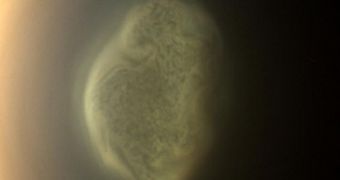Recent observations of Titan – Saturn's largest moon – have revealed that seasons are changing on the distant world. High in its hazy atmosphere, a large vortex is materializing, surrounded by high-altitude haze. The Cassini spacecraft sent back images of this amazing phenomenon.
The image to the left was captured by the NASA Cassini orbiter on June 27, 2012, and depicts Titan in true-color. The photo is centered on the moon's south pole, which was always a point of attraction for scientists operating the spacecraft.
Titan is extremely interesting for scientists because it is the most Earth-like object ever discovered. It has an extremely thick, orange atmosphere, and natural cycles within it, including storms and lightnings. Additionally, the Saturnine moon also features a large number of lakes.
The most important difference between it and our planet is that all natural cycles on Titan are based on liquid hydrocarbons, such as methane or ethane, rather than on water. This is due to the fact that average temperatures on the moon reach −179.5°C (93.7 Kelvin).
Titan also has seasons, and the new Cassini observations suggest that winter is coming to its southern hemisphere. “The structure inside the vortex is reminiscent of the open cellular convection that is often seen over Earth's oceans,” researchers Tony Del Genio explains.
“But unlike on Earth, where such layers are just above the surface, this one is at very high altitude, maybe a response of Titan's stratosphere to seasonal cooling as southern winter approaches. But so soon in the game, we're not sure,” adds the expert.
Del Genio holds an appointment as a Cassini team member at the NASA Goddard Institute for Space Studies (GISS), in New York. He says that in 2004, when Cassini arrived at Saturn, the northern hemisphere winter was settled on Titan.
On May 22 and June 7, Cassini used its Visual and Infrared Mapping Spectrometer (VIMS) instrument to obtain the first, false-color data on the moon's atmosphere, explains Christophe Sotin.
“VIMS has seen a concentration of aerosols forming about 200 miles [300 kilometers] above the surface of Titan's south pole. We've never seen aerosols here at this level before, so we know this is something new,” adds the expert, a VIMS team member based at the NASA Jet Propulsion Laboratory.
The JPL, in Pasadena, California, manages Cassini for the NASA Science Mission Directorate, at the American space agency's Headquarters, in Washington DC. JPL is managed for NASA by the California Institute of Technology (Caltech).

 14 DAY TRIAL //
14 DAY TRIAL //